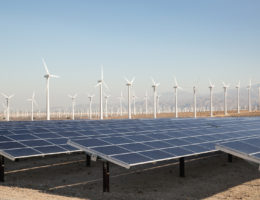The following is the content of an article by Grzegorz Mikos, legal counsel in the firm’s energy law team, which appeared in Real Estate Magazine. The publication deals in particular with solutions allowing managers of shopping centers, industrial parks or warehouse facilities to sell electricity, including energy produced in their own photovoltaic installations.
Own distribution network – opportunities and threats for property owners and managers
In order to rent a space, electricity must be brought to it. In the reality of shopping malls, industrial and logistics parks, and even office buildings, bringing in power requires a significant investment from the investor. Organizing its own distribution network opens up new opportunities for facility owners. However, this action is associated with numerous administrative burdens.
INTERNAL ELECTRICAL INSTALLATION AND ITS LIMITATIONS
Many times tenants of space are connected to internal electrical installations. The electricity they consume is measured by means of so-called sub-meters. Energy settlements with tenants are made on the basis of a re-invoice. The problem of accounting for losses in supplying electricity to tenants then arises. The amount of losses is affected by the length of the energy supply lines, as well as the possible use of transformers.
The situation is complicated by the unequivocal position of the ERO President in Announcement No. 11/2018 On Ensuring the Exercise of the Rights of End-Users in the Electricity Market. The ERO President opposes the addition of any surcharges to the electricity so delivered.
In the opinion of the ERO President, if a given entity does not intend to engage in the business of distribution and energy trading and does not have an infrastructure that meets the conditions of the electricity grid, but at the same time wants to ensure the possibility of using electricity, for example, in buildings owned by it with residential and commercial premises, inhabited or used by persons who are not consumers (i.e., persons who do not have contracts concluded with the energy company), the regulation contained in Article 45a of the Energy Law should apply accordingly.
According to Article 45a (1) of that law, an energy company calculates charges for electricity supplied to a customer on the basis of prices and rates of charges contained in the tariff or prices and rates of charges determined on the competitive market, as referred to in Article 49 (1). These charges – taking into account discounts and rebates granted to the customer – constitute the cost of purchasing electricity supplied to a building with residential and commercial premises, inhabited or used by persons who are not customers (Article 45a, paragraph 2).
The cost of purchasing energy shall be accounted for in the fees charged to the persons referred to above. The amount of the fees should be determined in such a way as to ensure that they exclusively cover the costs incurred for the purchase of electricity (Article 45a(4)).
The solution assuming the use of internal installations for the supply of electricity deprives tenants of the possibility, guaranteed by the Energy Law, to buy electricity from the seller of their choice. This right is vested in the customer. An entity that bills for energy through third parties, such as facility owners or operators, is not an energy consumer.
A customer, as defined by the Energy Law, is anyone who receives or consumes fuel or energy on the basis of a contract with an energy company. In view of this, tenants billed according to a re-invoice issued on the basis of sub-meter readings are not consumers, nor do they have the rights of consumers.
Tenants, especially foreign ones, increasingly want to consume so-called green energy. In 2021, the simplest solution is still to allow them to use the so-called “discount system. However, in order for a tenant to become a prosumer, he or she must conclude a comprehensive contract with the energy seller.
The supply of energy can take place on the basis of a comprehensive agreement containing provisions of a sales contract and a contract for the provision of energy transmission or distribution services.
In practice, an entity connected to the distribution company’s network can become a prosumer. The supply of electricity through the facility’s existing indoor installation prevents tenants from benefiting from the prosumer support system.
SOLAR ENERGY NOT FOR EVERY TENANT
Extensive, slightly sloping or flat roofs of logistics and industrial parks, as well as shopping malls, can be an excellent place to deploy photovoltaic installations. However, in order to supply electricity to tenants, such as under a so-called cPPA, it is necessary to feed it into the distribution grid.
The Corporate Power Purchase Agreement (cPPA for short), based on actual energy supply, involves the sale of electricity from the generator directly to the customer, with the involvement of a third party – a commercial balancing entity – required.
OWN DISTRIBUTION NETWORK – LEGACY OF A BYGONE ERA OR BUSINESS OPPORTUNITY?
When we talk about distribution companies, we usually think of companies of the largest Polish energy groups and Innogy, which operates in Warsaw. Certainly, these are the biggest players. However, information published on the website of the President of the Energy Regulatory Office shows that there are 184 distribution system operators in Poland. Among them, a sizable group are companies operating in the production, logistics and office space market.
RESPONSIBILITIES OF HAVING A DISTRIBUTION NETWORK IN THE FACILITY AREA
I think the main reason why facility managers and owners shy away from organizing their own distribution network is the many formalities involved in running a licensed business. Running an electricity distribution business requires, among other things, obtaining a license, as well as a so-called operator’s decision.
The distribution system operator is required to collect from customers, among other things, a transition fee, a RES fee, a cogeneration fee and a power fee.
The fees charged to customers by the distribution company cannot be freely shaped. The company is required to develop a tariff and submit it to the ERO President for approval. The tariff must comply with the tariff regulation. The amounts set must ensure that justified costs are covered.
Distribution companies must prepare so-called instructions for the operation and maintenance of the distribution network.
One of the concession requirements is also the need to provide adequate personnel.
According to the Law on Renewable Energy Sources, distribution system operators report to the ERO President by September 15 of each year information on the electricity sellers with the highest volume of electricity sales in the period from January 1 to August 31 of that year. On the basis of this information, the ERO President appoints a so-called “obligated seller” in the area of each distribution system.
At the initial stage of operations, distribution system operators, in view of the multiplicity of regulations and reporting obligations, use the assistance of law firms and consulting companies, which may increase the cost of their operations.
THE AMENDED LAW REMOVES SOME OF THE BUREAUCRATIC OBSTACLES
An important step towards reducing bureaucratic obstacles to small-scale distribution operations is the introduction of the concept of closed distribution systems into the Polish legal system.
Article 9da (1) of the Energy Law, as provided for in the Act of May 20, 2021 amending the Energy Law and certain other acts, indicates that the ERO President, at the request of a distribution system operator, states by decision that a distribution system in a geographically limited area of an industrial plant, a commercial facility or a place for the provision of common services, to which no more than 100 household customers of gaseous fuels or electricity are connected to the network, is a closed distribution system if, with respect to the entire scope of the electricity or gaseous fuels distribution business conducted:1.
- for specific technical or safety reasons, the operation or generation processes carried out by the users of this system are integrated, or
- 50% of the volume of electricity or gaseous fuels distributed annually is consumed by the owner or operator of the distribution system, or enterprises affiliated with that owner or operator.
The benefit of becoming a closed distribution system is the exemption from the obligation to:
- submitting tariffs for approval;
- preparation of development plans.
However, exemption from the obligation to submit tariffs for approval does not mean that energy distribution fees will be allowed to be freely shaped. The maximum distribution fee charged by the operator of a closed distribution system may not be higher than the payment calculated according to the fee rates resulting from the tariff approved by the President of the ERO of the energy company to whose network it is connected, or in the absence of such connection, in whose area of operation the closed distribution system is located. The billing rules and conditions for the application of this tariff must be the same as in the tariff of this energy company.
BENEFITS FROM OWN DISTRIBUTION NETWORK
The company’s own distribution network offers a chance to recoup the capital invested in preparing the infrastructure to bring electricity to tenants.
This is particularly important in a situation where some large power companies are passing on the cost of supplying electricity to developers of residential and commercial space.
Tenants connected directly to the distribution network will gain the status of electricity consumers. This allows them to exercise their right to switch vendors. Due to the possibility of concluding a comprehensive contract, tenants in addition can obtain the status of prosumers and benefit from a system of discounts.
The distribution network also allows tenants to sell electricity generated on the roof of the facility. The possibility of sourcing electricity from renewable energy sources can be appreciated by those tenants who are part of corporations moving towards so-called zero-carbon.
SUMMARY
The decision to operate a licensed distribution business should be preceded by legal, economic and technical analysis, taking into account the realities of the facility. The decision can also be influenced by the attitude of individual distribution companies, which pass on the costs of expanding the distribution network to those supplying residential and commercial space to the market.
Grzegorz Mikos is a legal counsel specializing in energy law. He gained professional experience in the field of energy law in government administration, including the Energy Regulatory Office, the Ministry of Climate, and in reputable Warsaw law firms. As part of the energy law practice of Raczynski Skalski & Partners Radcowie Prawni Adwokaci Sp. p., he advises on matters related to electricity generation, storage, distribution and trading.
Full content of the publication
https://www.realestatemagazine.pl/artykul/wlasna-siec-dystrybucyjna-szanse-i-zagrozenia-dla-wlascicieli-i-zarzadcow-nieruchomosci



